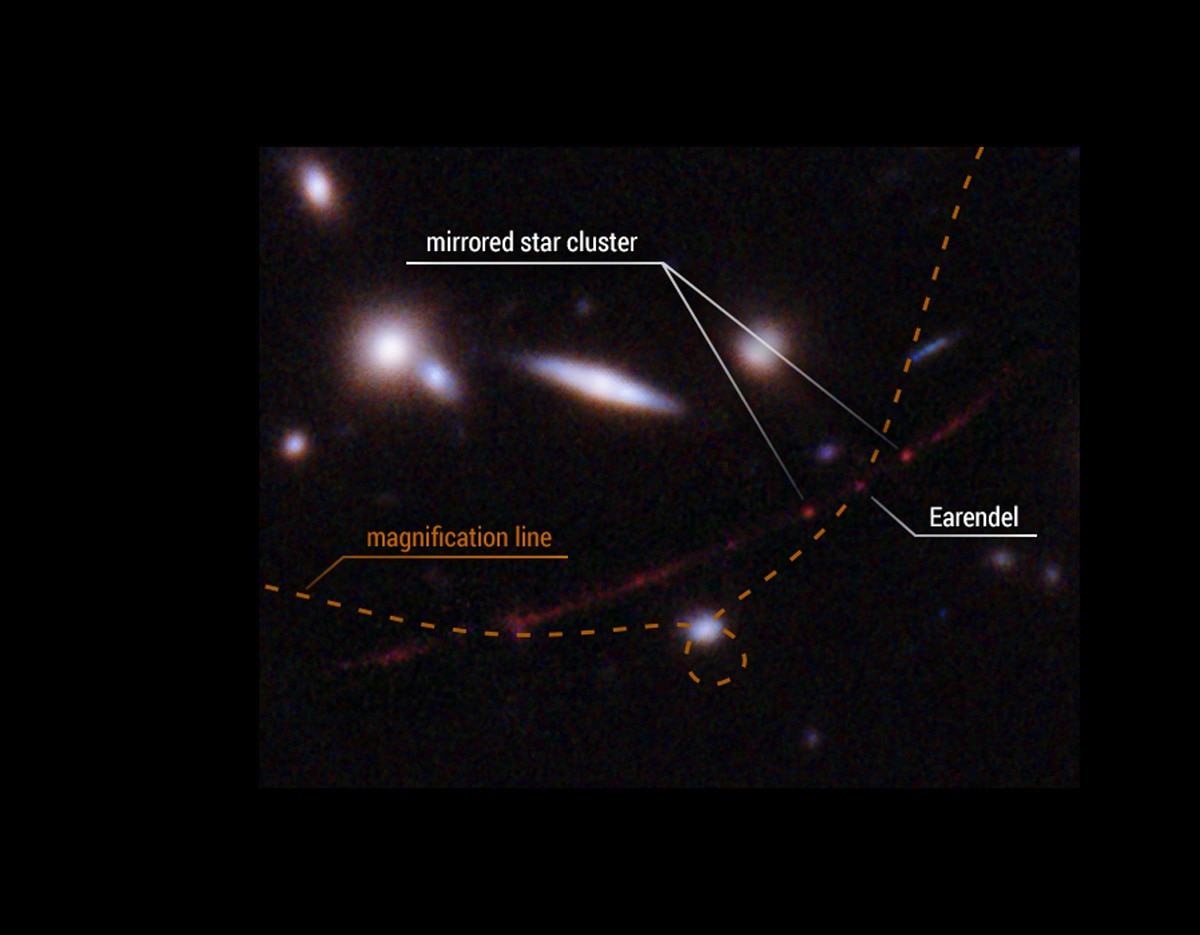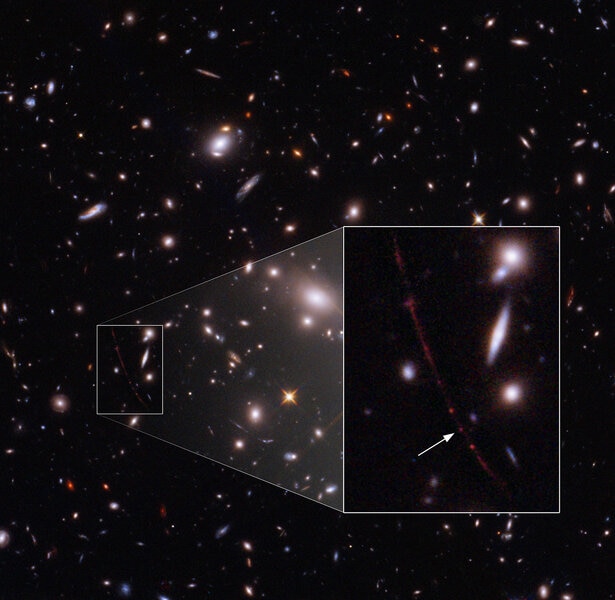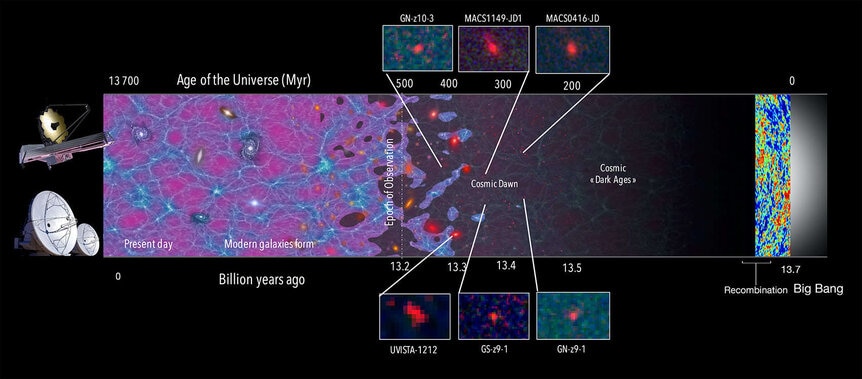Create a free profile to get unlimited access to exclusive videos, sweepstakes, and more!
Hubble sees the farthest star in the Universe
A gravity assist helps the 'scope see a star 12.9 billion light-years away.

Staring at the same spot in the sky for the better part of a day, Hubble Space Telescope — aided by a quirk of gravity that can massively magnify distant objects — may have spotted the most distant star ever seen… by a huge margin. If confirmed, the star is nearly 13 billion light years away, and we see it as it was when the Universe was only 900 million years old.
If confirmed, this is the farthest star in the Universe ever seen by humans.
!!!
There are some caveats and such, but even taking those into account this object is terrifically far away and very likely to mark a distance record that won’t be broken for a while [link to paper].
The star was found in a series of observations made of a cluster of galaxies called WHL 0137–08, located on the sky in the constellation of Cetus. Galaxy clusters can contain dozens to hundreds of galaxies, and WHL 0137-08 is a bruiser: Observations indicate it has a total mass of a whopping 900 trillion times that of the Sun, enough to make a thousand galaxies like the Milky Way.
WHL 0137-08 is about 5.5 billion light years from Earth, over a third of the way across the observable Universe. Still, there’s a lot of real estate on the other side of it, and many galaxies lie beyond. Here’s where the Universe itself helps us out: The gravity of a cluster of galaxies can distort the light coming from even more distant galaxies on its way to us. The distortion can multiply images of images of objects so we see more than one of each, it can warp the shape, and, most importantly here, it can magnify the brightness of the more distant object. This effect is similar to how a lens behaves, so it’s called gravitational lensing.
Way, way on the other side of the cluster is a previously unnamed galaxy, now called WHL 0137-zD1. The lensing has morphed the galaxy’s shape into a long arc, which the astronomers have nicknamed the Sunrise Arc. Along that arc are several brighter blobs, probably in reality multiple images of just two different clusters of stars.
But the real payoff here is that also along that arc is a single image of an object, what looks to be a lone star. That’s incredible: This galaxy is located about 12.9 billion light years from Earth — the Universe itself is only 13.8 billion years old, so we see this galaxy as it was when the cosmos was 900 million years old. It’s really, really far away.
Seeing a single star in a galaxy this distant is an astonishing stroke of luck. Gravitational lensing is complicated, and even more so when the lensing mass is a lumpy distribution of galaxies like a cluster. Some places can magnify images more than others, and there are peaks of magnification called critical curves, where technically the brightness magnification can be infinite; in reality it’s finite but can still be very large. One of these curves passes extremely close to the position of the star, and while it can’t be measured with exacting precision, the astronomers calculate the brightness magnification we see for the star is somewhere between a factor of 1,400 and 8,400! It’s possible, though less likely, the magnification could be as much as 40,000 times.
That’s why this star is visible at all. Without this extra kick to its brightness the star would be far too faint to see even with Hubble, by a factor of several hundred. Even so, it’s faint.
The models of its color and brightness indicate it’s a massive star, at least 50 times the mass of the Sun, and possibly more. Such stars can blast out so much light they’re 100,000 times more luminous than the Sun.
The astronomers gave the star the designation WHL0137-LS, but nicknamed it Earendel, from the Old English word meaning “morning star” or “rising light.” Appropriate, for a galaxy called the Sunrise Arc.
The big question is, is it a star? Or more specifically, is it a single star?
For example, a star cluster at that extreme distance can look so small it can be mistaken for a star. The astronomers in this work found that for these images this is unlikely, though; given how small the source is in the images they find the biggest it can be is a light-year, which is pretty small for a star cluster.
They cannot, however, exclude the possibility that this is not a single star, but a multiple system like a binary or trinary. Even if it is, though, multiple systems tend to have one star that seriously outshines the others. Even if it’s two stars, well, OK, then we’re seeing two stars 12.9 billion light years away. That’s still amazing.
Incidentally, several stars have been seen this way via cluster gravitational lensing, like one called LS1 in a galaxy 9 billion light-years from Earth. But this one destroys that record.
Mind you, the Universe was so young at this time that stars were a pretty new thing. The exact timing is hard to pin down, but the first stars were likely born something like 200 – 300 million years after the Big Bang, a period called cosmic dawn. That makes this star part of the very earliest generations of stars. So even if we do find stars more distant than this one, they won’t be too much more distant. They can’t be. They don’t exist much farther away. The Universe was too young to make them.
So how can this be confirmed? The astronomers already have a set of James Webb Space Telescope observations approved that are among its first science observations. Images and spectra should confirm or refute the idea that this is a single star, as well as refine our understanding of its characteristics and those of the star clusters seen along the Sunrise Arc. So we may know for sure either way in a year. Maybe less.
Stay tuned. If JWST can confirm this, it’ll be setting records right out of the gate. The most distant star… that’ll make an excellent journal paper title.





























